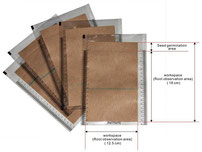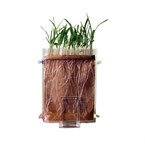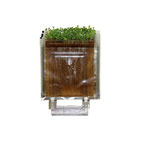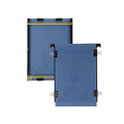Sterile Seed Germination Pouches - Lab Screening & Bioassays
Vienna Scientific offers PhytoTC germination pouches in Europe from mid to late 2024. The sterile pouches will be available in three sizes & "ready-to-use" for lab screening / bioassays on plant seedlings. Accessories for convenient, standardized placement during set-up (stands) and use (PhenoRacks) are available.
Ready-to-use Germination Pouches - Available later this year

Ready-to-use, Sterile Seed Germination Pouches, also known as plant culture bags, consist of two parts, i) a (sealed) plastic bag and ii) an inserted, specially folded germination paper. The top of the paper forming a trough for easy seed placement. The bottom of the trough is perforated, allowing roots to grow downwards along the creped paper. Larger pouches hold a larger perforation (for larger roots). The germination paper is inserted into a bag with a scale bar (starting below the perforation) to easily approximate root elongation. The sterile plant culture bags are available in three sizes, large (30 x 25 cm, height x width of "root observation area"; see Figure), medium (18 x 12.5 cm), and small (14 x 12.5 cm). Applications include root phenotyping, plant physiological and genetical research, and rapid plant bioassays / plant screening.

Germination Pouch Large, 30 cm
Quantity: 100 large pouches, including: 5 positioning panels
Size of germination paper below seed: Height: 30 cm, Width: 25.5 cm

Germination Pouch Medium, 18 cm
Quantity: 500 medium pouches
Size of germination paper below seed: Height: 18 cm, Width: 12.5 cm

Germination Pouch Small, 14 cm
Quantity: 500 small pouches
Size of germination paper below seed: Height: 14 cm, Width: 12.5 cm
Seed Germination Pouches - Features
- Three sizes - virtually fitting any seed and root size
- Sterile + can be sterilized (again)
- Standardized screening conditions
- Soil-free system, for clean use in laboratories
- Convenient and cost-effective
Options:
- Dedicated PhenoRacks (storage, shading) and positioning panels - for all sizes
- Stands (set-up and manipulation)
| Types / Components | Germination Pouches - 3 Sizes | OPEN | ||||||||||||||||||||||||||||||
|
|
||||||||||||||||||||||||||||||||
| References | Germination Pouches | OPEN |
|
||


How to: Seed Germination Pouches

- The Germination Pouches are easy to use and allow highly standardised and efficient experiments on whole seedlings (bioassays etc.), roots and rhizobia etc. under soil-free laboratory conditions. Below is a brief overview of how to start using the Germination Pouches for your daily experiments/screens. Show more
-
- Place the pouch in an upright position in PhenoRacks / stands or similar. Open the sealed pouch at the top at a height of your choice. Ensure that the germination paper is placed at the bottom of the plastic bag.
- Seeds are conveniently placed in the trough formed by the folded germination paper (see figure); seeds can be surface sterilised to prevent fungal contamination. For large seeds, the wick can be folded at the second perforation to make the trough deeper. Moisten the trough slightly for small seeds. For some species, the orientation of the seeds is important! Cuttings can also be rooted in the germination pouch by combining a number of perforations to match the diameter of the cutting.
- Gently add water or a nutrient solution of your choice. The initial amount of solution can be about 50 ml (large) and 15-20 ml (small, medium). As a general rule, start with less solution and add as needed. Cuttings may require more water.
- Darken the pouch area below the seed trough to prevent light effects on root development - use plastic bags, aluminium foil or a dedicated germination pouch PhenoRack / Light Shielding Panel.
- Place racks of germination pouches under a grow light or in a growth chamber. In high irradiance/high temperature conditions, consider partially closing the plastic sachets (with clips etc.) to reduce evaporation.
- Keep the germination paper moist, but do not over irrigate, as this may cause root rot / fungal growth. However, a shallow reservoir of solution at the bottom of the germination pouches will prevent unwanted drought stress.
- Wait for seeds to germinate. Observe or manipulate plant and root development and take samples at selected intervals. Add treatment of choice at any stage.
- Best practice: Harvest, stop experiment before / when roots reach the bottom of the pouch / solution reservoir.
Suitable plant species: Most seeds can be grown in the germination pouches and cuttings can be rooted - short pre-experiments with your target plants (at target temperature, light, etc.) will help to set the best experimental conditions. If the seed is very small (e.g. Arabidopsis or tobacco) it is best to use a small growing bag (GP-14), the smaller perforation at the bottom of the trough will hold the seed in place. If the seed is large (e.g. wheat, beans) or the trial period is longer, medium or large germination pouches are a better choice. For dicotyledonous seeds (e.g. soybeans) or hard-coated seeds (e.g. rice), it may be advisable to soak the seed prior to placement for faster germination.
Sterilisation: The bags can be sterilised at 121°C for 15 minutes, but the germination pouches are supplied sterile.
- Frequently Asked Questions (FAQ) on the use ... Show more
-
1. How does the seed germination pouch work?
The use is adressed above in detail. In brief, the paper has small perforations that allow the root to pass through, making the root development visible. The seeds are placed in the trough at the top of a folded germination paper and the water is deposited at the bottom of the sterile plastic bag. The water moves upwards through the paper by capillary action. When it reaches the trough, it moistens the seed.
2. How much water is initially put into the seed pouch?
Moisten the paper completely and keep it moist. In most cases, 15 to 20 ml (depending on the size of the seed) should be sufficient as an initial addition. Large bags may require up to 80 ml.
3. How often should the seed germination pouches be topped up with water?
This varies. Some plants (e.g. larger ones, some species) transpire water more quickly than others and in some environments (low humidity, high temperatures) evaporation is higher. The best criterion is to keep the growing paper moist at all times. Check the water level at the bottom of the bag regularly and add water in time to avoid (unwanted) drought stress.
4. Are there any nutrients or chemicals in the growth pouch?
No, the material does not contain any nutrients or chemicals. It is as inert as any standard growing / germination paper.
5. Can the germination pouch be reused?
No. The seed pouch is designed to be used only once. The paper is contaminated and starts to degrade after use, and does thus not allow for repeated standardized testing.
6. Is the pouch supplied sterile? Can it be sterilised?
Germination pouches are delivered sterile. However, all bags can be autoclaved (121°C, 15 min). To prevent fungal contamination, the seeds can be surface sterilised prior to insertion and the pouches should ideally be pre-prepared in a laminar flow cabinet.
7. How long can I grow plant seedlings in the bags?
This depends on the (root) growth rate. After three weeks of normal incubation conditions, the growth paper may begin to disintegrate. Thus, usually experimentation periods of 3–5 weeks can be realized. To study a larger, very fast-growing root system for extended periods, growth pouches or root phenoboxes with an increased height might be more appropriate although, all methods are based on growing paper with similar properties.
8. Can the germination pouches be used for larger seeds? What about small seeds?
Use the larger pouches for larger seeds and the medium or small pouches for smaller seeds. Users can prevent very small seeds (Arabidopsis etc.) from falling through the perforation by moistening the trough before placing the seeds.
Accessories for Seed Germination Pouches

PhenoRacks. For each of the seed pouch sizes, matching PhenoRacks are available - cost-effective storage containers with a rail system, allowing to store the plant culture bags, equipped with Light Shielding Panels, in a space-efficient, homogeneous and dark environment (for roots) in the lab or growth-chamber.

Pouch Manipulation / Preparation Stands. During set-up (entering seeds, watering etc.) the germination pouches are usually removed from the PhenoRacks. The manipulation & set-up stands, available in ~90° and 30° angled versions, are versatile accessories for placing the germination pouches on the lab bench while being worked on - reducing the risk of damaging protruding shoots.
Light Shielding Panels allow placing germination pouches outside PhenoRacks (e.g. on the lab bench) while avoiding any impact of light on root development. Manipulation Stands & Shading Panels matching the three germination pouch sizes readily available.
Application Potential of Germination Pouches - e.g. Herbicide Screening

- The aim of Zhang et al. (2015), for example, was to develop a bioassay for rapid diagnosis of herbicide dose-response and resistance in Echinochloa. The pregerminated seeds were then incubated in medium-sized germination pouches (see above) containing different concentrations of herbicides. Show more
-
Shoot and root lengths were measured and dose-response curves were constructed. Accurate dose-response curves were successfully generated for several herbicides with different modes of action by Zhang et al. (2015), suggesting that the germination pouch method can be successfully and conveniently used for rapid and cost-effective bioassays. In addition, the authors confirmed the suitability of the ready-to-use germination pouch method for rapid diagnosis of acetyl coenzyme A carboxylase (ACCase) and acetolactate synthase (ALS) inhibitor resistance and plant ecotypes resistance/susceptibility to ALS inhibitors. In summary, the results of Zhang et al. (2015) show that the germination pouch method can be reliably used in herbicide dose-response studies with significant time and cost savings compared to conventional whole-plant assays. The sterile, ready-to-use pouch systems can thus be used as an effective bioassay method for seedlings, which has been confirmed by several other studies (see reference list above).
For customized soil-free phenotyping, using "custom" germination paper, consider Growth Pouches (two variants with hard and soft cover) and Root Phenoboxes (with growth resistance).









